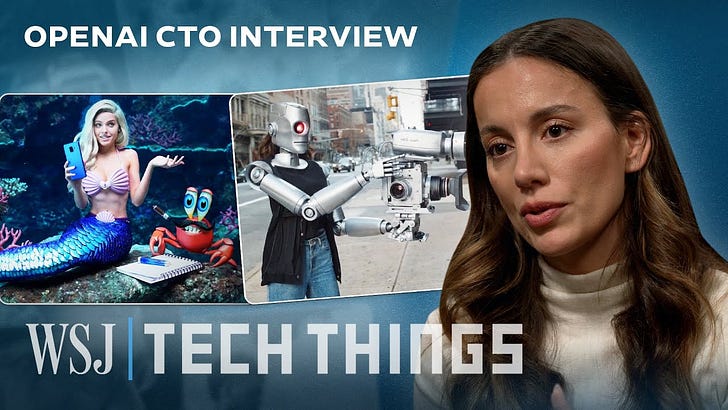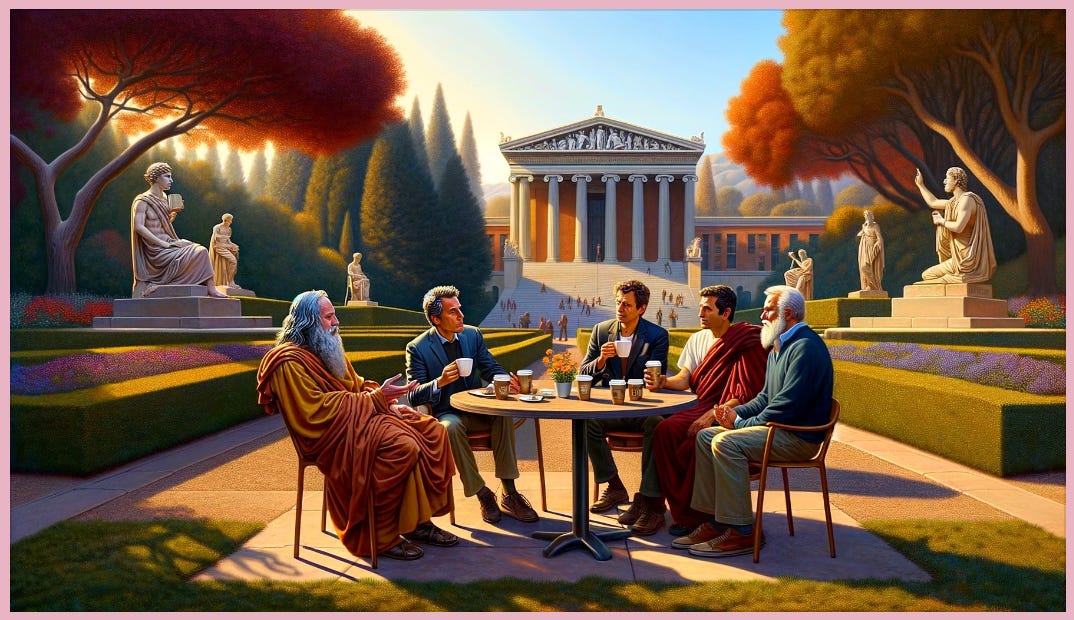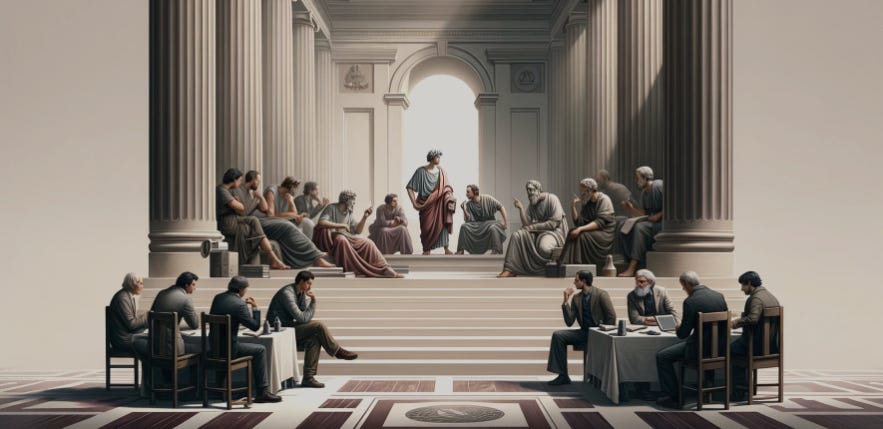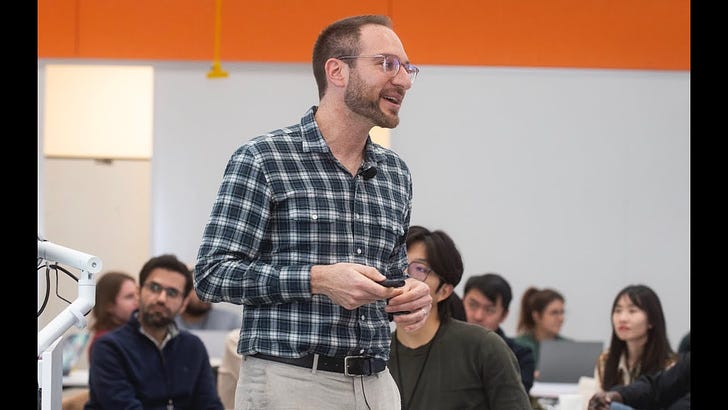BRIEFLY NOTED: For 2023-03-23 Sa
That the post-FTX bankruptcy team has managed to recover a lot of the value Sam Bankman-Fried stole does not mean he didn’t steal it; American commercial real estate sword-of-Damocles blogging...
That the post-FTX bankruptcy team has managed to recover a lot of the value Sam Bankman-Fried stole does not mean he didn’t steal it; American commercial real estate sword-of-Damocles blogging; the BEAST that is the Nvidia DGX GB200; Nvidia tries to become like Apple; Jacob Levy on academic freedom vs. free speech; Joanna Stern & Mira Mirati on OpenAI’s Sora video generator; global warming & cherry blossoms; very briefly noted; & NOTES: On Mid-21st Century Undergraduate Education, & Virgil's Prophecy of Jupiter: "Imperium sine Fine Dedi", READING: Brief Selections from John Maynard Keynes (1919): "The Economic Consequences of the Peace", PODCAST: Hexapodia LVIII: Acemoglu & Johnson Should Have Written About Technologies as Labor-Complementing or Labor-Substituting, & BRIEFLY NOTED: For 2023-03-18 Mo…
SubStack NOTES:
CryptoGrifters: An important point that Sam Bankman-Fried, the Stanford Law School mafia, Michael Lewis, & others are trying to bury in noise:
John Ray: ‘Vast sums of money were stolen by Mr. Bankman-Fried, and he was rightly convicted by a jury of his peers. That things that he stole, things he converted into other things, whether they were investments in Bahamas real estate, cryptocurrencies or speculative ventures, were successfully recovered through the enormous efforts of a dedicated group of professionals (a group unfairly maligned by Mr. Bankman-Fried and his supporters) does not mean that things were not stolen. What it means is that we got some of them back. And there are plenty of things we did not get back, like the bribes to Chinese officials or the hundreds of millions of dollars he spent to buy access to or time with celebrities or politicians or investments for which he grossly overpaid having done zero diligence. The harm was vast. The remorse is nonexistent… <https://arstechnica.com/tech-policy/2024/03/ftx-chief-lays-out-all-the-ways-sbf-sucks-in-detailed-court-filing/>
Economics: As long as there are not leveraged chains of interlinked borrowing, individual acts of "pretend and extend" have little if any implications for anyone other than the borrower, the lender, and the immediate owners and creditors of the lender. The rest of the business of financing and building can continue with deals struck with only an occasional side-eye and shudder glance at postponed workouts. Yes, regulators and investors need to watch those doing the rollovers like hawks. But as long as that process is underway, there is little reason to make accelerating workouts a big priority. But is that process underway?;
Gillian Tett: It’s time to be honest about America’s commercial real estate hangover: ‘“pretend and extend”… need[s] to end…. What is striking is… how little pain has been crystallised so far…. Lenders are rolling over bad loans…. The overall banking system is fairly well capitalised…. The Fed has scrambled to create systems to contain contagion.… The problem is that as long as these “pretend and extend” tactics are playing out, uncertainty will haunt the property sector, threatening to undermine American growth… <ft.com/content/12e0c608-25c2-41b3-829a-…>
MAMLM: The beast weighs 3000 lbs. 150 x 20 = 3000 chips. A total of perhaps 600 trillion transistors. At normal chip prices-per-transistor these days, that would be under $1,000,000. Apple and Wal-Mart, after all, are now selling a full M1 16-billion transistor laptop for $699. But people who might know are saying “low eight figures” or “custom quote”. Maybe the anomaly—given demand—is not that NVIDIA’s current margins are so high but that they are so low, that it is not trying to squeeze all the juice but is instead doing favors in the hopes of gaining goodwill that will be useful in the future:
Charlie Stross: ‘The Nvidia DGX GB200 server of 2024 consumes 120kW of power, about the same as the Cray-1 supercomputer of 1975. The Cray-1 cost $7.9M and ran at 160 MFLOPS. The GB200 runs at 1.44 exaFLOPS, or roughly ten billion times the power. But you can network 8 of these racks together, and AWS is building Project Ceiba around 20,736 of the CPUs (there are 72 CPUs per DGX server rack). 10 billion times more performance per watt, in 49 years… <http://en.wikipedia.org/wiki/Cray-1> <https://www.theregister.com/2024/03/21/nvidia_dgx_gb200_nvk72/> <https://mastodon.social/@cstross@wandering.shop/112135574940467336>
MAMLM: Nvidia is now trying to become Apple – roar up and down the stack in the hope of creating enough integration the sheer fact of that integration and the benefits from it will prevent it from being sliced to death as each thing is that it does gets commoditized:
Richard Waters: ‘NVIDIA’s “full-stack” approach… processors… interconnects… central processing units… to manage the process… software… programming models and libraries of code… Cuda…. The more tools that Nvidia and its partners create to take its technology deeper into individual industries—something currently happening at lightning speed—the more invested they will be in its underlying chip architecture…. Pre-trained AI models… calls NIMs… “co-pilots”… integrated into IT processes…. All of this has had Wall Street analysts salivating about which Big Tech markets Nvidia will turn to next…. For now, focusing the entire computing stack on satisfying the red-hot demand for AI chips makes sense. For would-be chip rivals, this week’s event was a daunting reminder of the speed at which Nvidia is moving and the sheer range of complementary technologies it is building… <ft.com/content/81f7a8e6-1738-4339-a893-…>
Public Reason: The problem with a university’s balancing near-total freedom of “extramural speech” on one hand with freedom of scholarly inquiry on the second hand and with protection of the rights of all members of the university to feel welcome and valued inside the institution on the third is this: quite often one of the major purposes of the “extramural speech” or of the “scholarly inquiry” is to make some members of the university community feel profoundly unwelcome. Does anybody believe that Harvey C. Mansfield blamed grade inflation at Harvard on the admission of African-Americans who, he said, could not keep up because he knew anything about the issue, or because he wanted to make African-Americans feel unwelcome. Does anybody believe that the fact that Charles Murray burned a KKK cross to terrorize his Indiana neighbors was not a plus for those at Stanford who invited him for purposes of “scholarly inquiry”? Just as the attempt to draw bright lines is futile in internet moderation, so the search for principled bright-line boundaries is futile here. But that is why university administrators are paid the relatively big bucks—to be sensitive to context and nuance, and to think about how to balance all three of these off against one another:
Jacob T. Levy: Campus culture wars are a teachable moment in how freedom of speech and academic freedom differ: ‘The principles governing university life are… strange… counterintuitive… complicated to defend… tempting to abandon... educators haven't put in the work….
Undergraduate activists on any issue are often prone to immoderation…. Universities offer very robust protection for political and protest speech… as an incidental byproduct… [of] academic freedom… to follow arguments and evidence where they lead, according to scholarly methods... to teach, within the confines of the scholarly mission of the class… limited by the freedom of students to be secure that they will be assessed fairly.... The front of the classroom isn't a pulpit or a political platform.
But within those constraints, professors have substantial freedom… to teach… [plus] freedom from evaluation on non-academic grounds…. An economist couldn't be fired for being an atheist, a mathematician for being a socialist…. The technical phrase here is freedom of extramural speech.... Protections of extramural speech are very strong… to protect the academic integrity of what goes on inside….
[That is] very strong protection for the freedom of protest, not because protest is important to a university the way it is to a democratic society, but because it's academically irrelevant. It's wrong to question a student's (or professor's) standing in the academic community because of what they say at a protest…. The only appropriate limits are not about the content of what's said, but about the conduct of the protest action....
When faced with demands to denounce Hamas, or student activists who endorsed Palestinian armed resistance, or Israel, or Zionist speech on campus, or whatever, universities often fell back on the rule of institutional neutrality. But critics found it hard to take that rule seriously…. The rule that the university shouldn't take any interest in the rhetoric that's used in a protest or on social media was harder to take seriously in an era of hate-speech rules, restrictions on exclusionary speech… a discourse around "safety" that treated hostile language as violence… by critics who noted that denouncing bad things and restricting hateful or unsafe speech seemed to be very much part of the institutional tool kit these days. These were problems of universities' own making….
Jewish and pro-Israel members of university communities... have seen universities themselves shift away from the principles of academic freedom, freedom of nonacademic speech, and institutional neutrality, often in the name of protecting vulnerable populations, and, in the wake of the murders of Oct. 7, asked whether Israeli Jews are somehow outside the category of the vulnerable...
The best time to have started to do the right thing was yesterday, but the second-best time is today. University leadership… can recommit to academic freedom, freedom of extramural speech, and institutional neutrality, starting now… <theglobeandmail.com/opinion/article-cam…>
ONE VIDEO: Joanna Stern & Mira Mirati: OpenAI’s Sora:
ONE IMAGE: Global Warming:
Very Briefly Noted:
Economics: Nicola Gennaioli, Andrei Shleifer, & Robert Vishny (2014); Finance & the Preservation of Wealth: ‘A Solow-style neoclassical growth model with diminishing returns to capital. Savers rely on trusted intermediaries to manage their… claims on capital stock…. [Intermediaries] can charge fees above costs to trusting investors…. The ratio of financial income to GDP increases with the ratio of aggregate wealth to GDP…. Further implications… for management fees, unit costs of finance, and the consequences of shocks to trust and to the capital stock…. Some see the growth of finance as an indication of problems with the market economy and the financial system. Without denying the importance of rent-seeking, agency, and other problems, our article presents a more benign view. Finance should grow as an economy matures, because the preservation of wealth is an increasingly important function of the financial system… <https://scholar.harvard.edu/files/shleifer/files/the_quarterly_journal_of_economics-2014-gennaioli-1221-54.pdf>
Preston Mui: How we could return to the productivity growth of the 1990s: ‘The immediate macroeconomic environment plays a significant role in producing higher productivity growth…. The late 1990s were also a uniquely good time for the US macroeconomy…. Alan Blinder and Janet Yellen termed the 1990s the “Fabulous Decade”… full employment, a boom in fixed investment, and a stable supply-side…. Why was there such a boom in fixed investment in the 1990s?… Three stars aligned… strong aggregate demand… the federal government played a critical role in coordinating research and development in semiconductors under a “science policy” model…. Financial conditions were relatively looser…. In the 1990s, the US economy was able to avoid the inflationary shocks and cost growth in essentials that upset other recoveries…. Could we recapture the spirit of the 1990s, today?… Building a stable and secure supply side looks like it may require the most work…. Hope is not a strategy for ensuring supply side abundance…. Public policy may not be able to simply will technological improvements into existence, determine whether AI is actually going to be useful, or meaningfully affect the demographic trajectory of an aging population. What policy can do is ensure that the macroeconomic backdrop is supportive of investments in technological improvements and that the broader economy is in a position to translate those improvements into economic activity…
Dan Davies: : ‘Although the peaks of intellectual achievement in economics are high, the base line of knowledge is often surprisingly low, and this isn’t recognised in practice…. You all too often come across people who don’t have a sufficient baseline of knowledge outside their specialty, but who either aren’t aware of this or don’t see it as a reason not to give advice…. They know that their own speciality is complicated, fragile and beset by special cases, but their perception of all the rest of economics is that it’s pretty easy stuff which can be figured out from first principles in a coffee break with a few simple axioms…. If you can find…, a professional economist with direct research experience, or past personal involvement with a policy issue… [they are] likely to understand it pretty well…. [Otherwise] you’re much better off listening to a generalist or newspaper commentator who will at least hopefully have glanced at the facts rather than trying to do it all on the back of an envelope…
Economic History: Mark Koyama: Reflections on Pox Romana: ‘Pox Romana is a great book… by ancient historian Collin Elliott… an important work of ancient history… that I recommend highly for both casual and scholarly readers…. The Roman empire had bloated “consumption” cities…. Interesting is Elliott’s analysis of the Roman response to the plague... ad hoc and shortsighted. In response to poor harvests in Egypt, the Roman state repurposed ships that had previously supplied mines and quarries to move grain and “as a consequence, operations designed to extract and transport” others goods “may have declined, or even paused”. Many mining sites were abandoned in the decades following the plague. As state revenues collapsed, tax collection became more coercive prompting fiscal flight among peasant farmers.
Elliott argues that “state intervention . . . burdened labor markets further”…
Johan Fourie: When historians ignore economics: ‘Humanities students fail to recognise the remarkable progress we've made, to the detriment of future generations…. For many years I gave a guest lecture to second-year History students at Stellenbosch. It usually followed the National Budget Speech by South Africa’s Minister of Finance. The purpose of the lecture was to distil the budget for humanities students enrolled in a course on the history of wealth and poverty, from ancient times to the present…. 80% of the world, I would tell them, lived on less than $2 a day in 1800, basically just above subsistence. Today that is 8%. (Also, today we are 8 billion people compared to the 1 billion back then.) That is a truly remarkable transformation…. What always surprised me was the profound sense of unease in the classroom. This unease was a consequence of a message that had been drilled into them by all their humanities lecturers: that the rich have become rich through expropriating land or labour, a belief that wealth was not the product of innovation and hard work but rather the result of exploiting resources and people…. In my brief class discussion of the causes of the Industrial Revolution and the technological innovations that followed, students could only note the exploitation of the English workers or the exploitation of those in the British colonial empire…. They know little about the remarkable increase in worker wages… scientific discoveries and associated technologies like the Haber-Bosch process that now provide nutrition for more than three billion people, or the creation of penicillin, saving millions of lives, or the transistor that connects me to the world (and to you).… To avoid this one-sided view of history, History departments would do well to incorporate more economic history texts that acknowledge both the triumphs and trials of the past into their curriculums. Yet, given the resistance to these ideas within the humanities, I don’t expect this to happen soon. I’ve not been invited back to give the guest budget speech lecture for the last two years…
Cognition: Kevin Dickinson: Why memory is more about your future than your past: ‘Memories aren’t mental recordings, but pliable information we can use to better manage the present and conjure future possibilities…. [Charan Ranganath:] “If the goal was to store everything in some mental vault, then from that perspective, memory is faulty. But if the goal is to use the past in meaningful ways, combine different experiences creatively, or consider new possibilities, then our memory is doing exactly what it should be. For instance, the brain is optimized to process information quickly and then generate a prediction about what’s going to happen next. The value of that predictive processing is not only that it’s fast; it also optimizes the information you get. Even when our predictions are wrong, that orients us to where the new, important information is… <https://bigthink.com/the-learning-curve/why-memory-is-more-about-your-future/>
CryptoGrifts: Joe Weisenthal: What Joe’s interested in this morning: ‘A couple of weeks ago, I wrote that this crypto bull market was different, because there's (blissfully) almost no talk about the underlying tech. Nobody's talking about "Web3" of "world computers" or anything like that. The theme is entirely flows based. The approval of the ETFs widens the lanes for institutional money to flow into Bitcoin, and so everyone just wants to frontrun the next person, who will be trying to frontrun the person after that…. Once you establish that the entire thing is about flows and frontrunning, then there's no reason to just stick with Bitcoin. And there's no reason to go with coins that have any pretense of soundness or sustainability.
And so we've seen the mother of all memecoin bull markets emerge…. One thing that's interesting though is that people are going for low-cost chains, like Solana, at the expense of more decentralized, older chains such as Ethereum…. Crypto in its most honest form. No talk of use case. No talk of decentralization. No talk of network security or anything like that. Just low-cost gambling… <https://www.bloomberg.com/news/newsletters/2024-03-19/five-things-you-need-to-know-to-start-your-day-americas?cmpid=BBD031924_MKT>
Human Capital: K.C. Raybould: It's Not About Humanities Vs STEM, It's About Systematic Thinking: ‘Tech bros… see themselves as philosopher kings —and… read and study history and philosophy and find in those humanities justification for not letting woman vote and for denigrating democracy and valorizing Spartans (despite the Spartans being among history's greatest losers). “The central message of Buddhism is not "Every man for himself." And the London Underground is not a political movement. Those are all mistakes, Otto. I looked them up.” and all that. Conversely, anti-vax, COVID denial, and the credulous press OpenAI and before that crypto huskers receive is a function of people not understanding the science and technology well enough to sniff out potential nonsense. The fact that the CTO of OpenAI could not handle a question as simple as “did you scrape YouTube videos for your training data” shows just how inadequate the questioning of these people has been up until now, and thus, just how inadequate the scientific education most of our journalists have received and absorbed actually is…
Science: Abraham Pais (1979): Einstein & the Quantum Theory: ‘This is an account of Einstein's work and thoughts on the quantum theory. The following topics will be discussed: The light-quantum hypothesis and its gradual evolution into the photon concept. Early history of the photoelectric effect. The theoretical and experimental reasons why the resistance to the photon was stronger and more protracted than for any other particle proposed to date. Einstein's position regarding the Bohr—Kramers —Slater suggestion, the last bastion of resistance to the photon. Einstein's analysis of fluctuations around thermal equilibrium and his proposal of a duality between particles and waves, in 1909 for electromagnetic radiation {the first time this duality was ever stated) and in January 1925 for matter (prior to quantum mechanics and for reasons independent of those given earlier by de Broglie). His demonstration that long-known specific heat anomalies are quantum effects. His role in the evolution of the third law of thermodynamics. His new derivation of Planck's law in 1917 which also marks the beginning of his concern with the failure of classical causality. His role as one of the founders of quantum statistics and his discovery of the first example of a phase transition derived by using purely statistical methods. His position as a critic of quantum mechanics. Initial doubts on the consistency of quantum mechanics (1926—1930). His view maintained from 1930 until the end of his life: quantum mechanics is logically consistent and quite successful but it is incomplete. His attitude toward success. His criterion of objective reality. Differences in the roles relativity and quantum theory played in Einstein s life. His vision regarding quantum theory in the context of a unified field theory. His ast autobiographical sketch, written a few months before his death, concluding with a statement about the quantum theory, a subject to which {by his own account) he had given more thought than even to general relativity… <https://batistalab.com/classes/vvv/RevModPhys.51.863.pdf>
Science Fiction: T. Kingfisher: Paladin's Grace: 'In the orphanage she had been raised in, hardly anyone worried much about their mother and father. Everyone's goal was to get an apprenticeship to a kind master, and a field, where they would be wealthy and respected and eat three meat meals a week... <https://argyllproductions.com/our-authors/ursula-vernon/>















Tett: I've no opinion on banks rolling over commercial real estate loans unless (and I'm afraid it does) it interferes with shifting the assets into some more useful employment (at probably a lower rent). There is certainly something odd about real estate standing vacant. It clearly has something to do with rents not easily adjusting downward and doesn't THAT have something to do with how commercial real estate is financed?
"The Dunning School"?! Oh come on. Now the writers are just mailing it in.
On one point Raybaud is surely wrong: to first order, and maybe to second order too, it is not the case that science advances "one funeral at a time." It is almost the definition of science that this claim is false, and it is also what is observed empirically. The old guard defend their theories stubbornly so long as it is feasible to do so; but once evidence against them gets strong enough, they all surrender together. The result is more like a phase change than a gradual decay. I remember Penrose describing this process well, with respect to his own ideas about black holes.